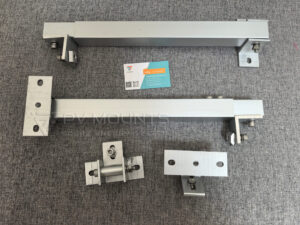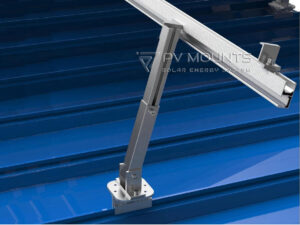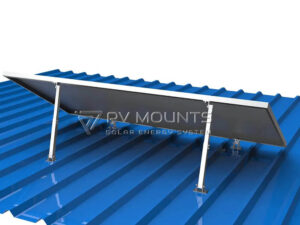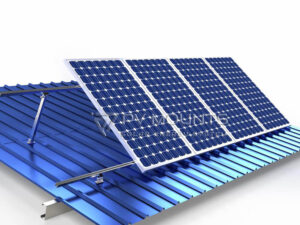Solar mounting systems are crucial for efficient solar energy capture. Standing seam roofs are ideal for these installations, offering a perfect blend of form and function. Solar mounting systems are engineered marvels that harness the sun’s power with precision and reliability. The available options are innovative and varied, including clamp-based and rail-less designs, each offering a streamlined aesthetic.
In this exploration, we’ll journey through the realms of solar technology, uncovering the intricacies of mount systems and their symbiotic relationship with standing seam roofs. The narrative is not just technical but also a story of advancement, highlighting how these systems have evolved to meet the demands of both the environment and the energy-conscious consumer.
Table of Contents
Advantages of Standing Seam Solar Mount
Standing seam roofs, known for their durability and sleek appearance, provide more than just aesthetic appeal; they are a fortress for solar installations. These roofs are characterized by their raised seams, which run vertically along the roof, creating a series of ridges and valleys. This unique design not only contributes to their striking visual appeal but also enhances their structural integrity, making them an ideal host for solar panels.
One of the standout benefits of standing seam roofs is their longevity. These metal roofs can withstand harsh weather, providing a sturdy base for solar panels for decades to come. Moreover, their design minimizes the need for penetrative installation methods, which can compromise roof integrity and lead to potential water ingress.
Another significant advantage is the ease of installation. The solar mounting systems on standing seam roofs can often be attached directly to the seams, eliminating the need for drilling holes. This not only speeds up the installation process but also reduces the risk of leaks, ensuring the roof remains intact and weatherproof.
In summary, standing seam roofs offer an optimal combination of durability, ease of installation, and minimal maintenance, making them a premier choice for solar panel installations. They embody a harmonious blend of form and function, providing a reliable and aesthetically pleasing solution for those seeking to embrace solar energy.
Types of Solar Mounting Systems for Standing Seam Roofs
The world of solar mounting systems is diverse, with each type tailored to fit the unique contours of standing seam roofs. At the forefront are clamp-based systems renowned for their non-intrusive installation method. These systems utilize special clamps that attach directly to the seams of the roof, securing the solar panels in place without the need for drilling, thereby preserving the roof’s integrity and warranty.
Rail-less systems represent the next evolution in solar mounting technology. By eliminating the need for traditional metal rails, these systems offer a sleeker, more integrated appearance that complements the modern aesthetic of standing seam roofs. The solar panels are mounted directly onto the clamps fixed to the seams, reducing material usage and streamlining the installation process.
Integrated systems take this integration a step further, blending the solar panels and the roof surface into a seamless unit. These systems often involve specially designed solar panels that double as roof panels, not only generating electricity but also forming a part of the roof itself. This integration achieves a level of aesthetic harmony and efficiency that traditional systems struggle to match.
Each type of solar mounting system offers its own set of benefits, from the straightforward installation of clamp-based systems to the aesthetic and functional integration of integrated systems. The choice depends on the property owner’s specific needs and preferences, with each system providing a robust, efficient, and aesthetically pleasing solution for harnessing solar energy on standing seam roofs.
Technical Considerations for Installation
Embarking on the journey of installing solar mounting systems on standing seam roofs demands meticulous technical consideration. The process begins with a comprehensive assessment of the roof, ensuring its compatibility with solar installations. Factors such as roof age, material, and structural integrity are scrutinized to guarantee that the foundation can support the solar array’s weight and withstand environmental pressures.
Solar panel orientation is crucial for maximum energy production. Ideally, panels should face south in the Northern Hemisphere. The tilt angle, tailored to the geographic location, enhances the panels’ ability to absorb solar energy efficiently. Moreover, environmental factors like shading, wind load, and snow load must be evaluated to ensure the system’s resilience and performance longevity.
Navigating these technicalities requires not only engineering expertise but also an intimate understanding of local climate patterns and building codes. This meticulous approach ensures that the solar mounting system is not only technically sound but also optimized for long-term energy production.
Installation Process of Solar Mounting Systems
The installation of solar mounting systems on standing seam roofs is a symphony of precision and planning. The process unfolds in a series of well-orchestrated steps, starting with the secure attachment of clamps or brackets to the roof’s seams. These attachments serve as the foundation upon which the solar panels will rest.
Following the attachment phase, the solar panels are methodically mounted onto the framework, ensuring each panel is securely fastened and electrically connected. The wiring process is executed with a keen eye on safety and functionality, integrating the solar array into the property’s electrical system. This integration is capped off with the installation of inverters, which convert the direct current (DC) generated by the panels into alternating current (AC), suitable for home or business use.
Throughout the installation process, the use of specialized tools and equipment is paramount to achieving a seamless and efficient setup. These tools facilitate the precise alignment and secure attachment of the solar panels, ensuring their optimal performance and durability. The entire process, guided by the hands of skilled technicians, culminates in a fully functional solar energy system that stands as a testament to the synergy between technology and sustainability.
Maintenance and Care of Solar Systems
Post-installation, the maintenance and care of solar systems become integral to sustaining their efficiency and longevity. Routine checks are essential to identify and rectify any potential issues, such as loose connections, debris accumulation, or wear and tear. Regular cleaning of the solar panels is also crucial to maintain their energy absorption efficiency, as dust, leaves, and other obstructions can significantly reduce their performance.
Addressing common issues like inverter malfunctions or shading impacts promptly ensures the system operates at its peak. Technicians equipped with diagnostic tools and expertise can quickly resolve such problems, minimizing downtime and energy loss.
The care regimen for solar systems on standing seam roofs emphasizes preventive measures, aiming to avert issues before they escalate. This proactive approach not only extends the system’s life but also maximizes its energy production, ensuring a reliable and effective solar energy solution for years to come.
Cost Analysis and ROI of Solar Systems on Standing Seam Roofs
The financial landscape of installing solar systems on standing seam roofs encompasses an initial investment that unfolds into long-term savings and substantial return on investment (ROI). The upfront cost, while significant, is mitigated by the myriad of financial incentives available, such as tax credits, rebates, and grants. These incentives, aimed at promoting renewable energy adoption, can substantially reduce the net cost of solar installations.
Analyzing the ROI involves comparing the initial setup costs against the ongoing savings from reduced utility bills. Solar systems typically pay for themselves over time through these savings, with payback periods varying based on factors like local energy prices and solar insolation levels. Additionally, solar installations can increase property values, offering an indirect financial benefit to property owners.
Beyond the immediate financial considerations, the long-term perspective reveals a scenario where solar energy significantly decreases electricity costs, especially as traditional energy prices continue to rise. This economic advantage, coupled with the environmental benefits of renewable energy, positions solar systems on standing seam roofs as a wise investment in both financial and ecological terms.
Future Trends in Solar Roofing Technology
The horizon of solar roofing technology is marked by innovative trends and advancements that promise to enhance the efficiency, aesthetics, and integration of solar systems on standing seam roofs. Technological innovations such as bifacial solar panels, which capture sunlight on both sides and thin-film solar technologies, known for their flexibility and lightweight design, are set to redefine the efficiency and application of solar roofing solutions.
Moreover, the integration of smart technology and solar systems is on the rise, with advancements in software and monitoring tools enabling real-time energy management and performance optimization. These tools not only improve the functionality of solar systems but also enhance the user experience, providing detailed insights into energy production and consumption patterns.
The future also holds potential for more seamless integration of solar panels into roofing materials, leading to the development of solar tiles and shingles that blend effortlessly with the aesthetic of standing seam roofs. This evolution towards more integrated and less obtrusive solar solutions signifies a move towards fully sustainable buildings, where solar energy plays a central role in architectural design and energy strategy.
Sustainability Impact of Solar Energy
The adoption of solar energy on standing seam roofs plays a pivotal role in the global movement towards sustainability. By harnessing renewable solar power, these systems contribute significantly to reducing carbon footprints and mitigating the impact of climate change. The clean, green energy produced by solar panels directly replaces the need for electricity generated from fossil fuels, leading to a substantial decrease in greenhouse gas emissions.
Beyond the environmental benefits, the sustainability impact of solar systems extends to socio-economic advantages. The growth in solar energy adoption fosters job creation in the renewable energy sector, promoting economic development while advancing environmental goals. Moreover, the shift towards sustainable energy sources like solar power enhances energy security and independence, reducing reliance on imported fuels and bolstering national energy resilience.
Conclusion: The Bright Future of Solar on Standing Seam Roofs
The integration of solar mounting systems on standing seam roofs signifies a transformative step in the pursuit of sustainable energy solutions. This combination not only capitalizes on the structural advantages of standing seam roofs but also aligns with global sustainability goals, offering a reliable, efficient, and eco-friendly energy solution. As technology advances and societal commitment to green energy strengthens, the future of solar on standing seam roofs shines brightly, promising a legacy of environmental stewardship and renewable innovation.
FAQs
How does the solar mounting system work with standing seam roofs?
Solar mounting systems on standing seam roofs use specially designed clamps or brackets that attach securely to the roof’s seams without penetrating the surface. This method maintains the roof’s integrity and provides a stable foundation for the solar panels.
What are the benefits of using standing seam roofs for solar panel installations?
Standing seam roofs offer durability, ease of installation, and minimal maintenance for solar systems. Their design allows for a non-penetrative attachment of solar panels, reducing the risk of leaks and ensuring long-term roof integrity.
Can solar mounting systems be installed on any standing seam roof?
While most standing seam roofs are suitable for solar mounting systems, a detailed assessment of the roof’s condition, material, and structure is essential to ensure compatibility and optimal installation.
What is the lifespan of a solar mounting system on a standing seam roof?
Solar mounting systems on standing seam roofs can last for 25 years or more, mirroring the lifespan of solar panels. Their durability is enhanced by the robustness of standing seam roofs and the non-invasive installation method.
How does weather affect the performance of solar panels on standing seam roofs?
Solar panels are designed to withstand various weather conditions, but extreme weather can affect their performance. Proper installation and orientation of the panels can minimize these effects, ensuring consistent energy production.
What are the maintenance requirements for solar mounting systems on standing seam roofs?
Maintenance is generally low, involving periodic cleaning of the panels and routine inspections to check for potential issues. This ensures the system operates efficiently over time.


-1.jpg)










